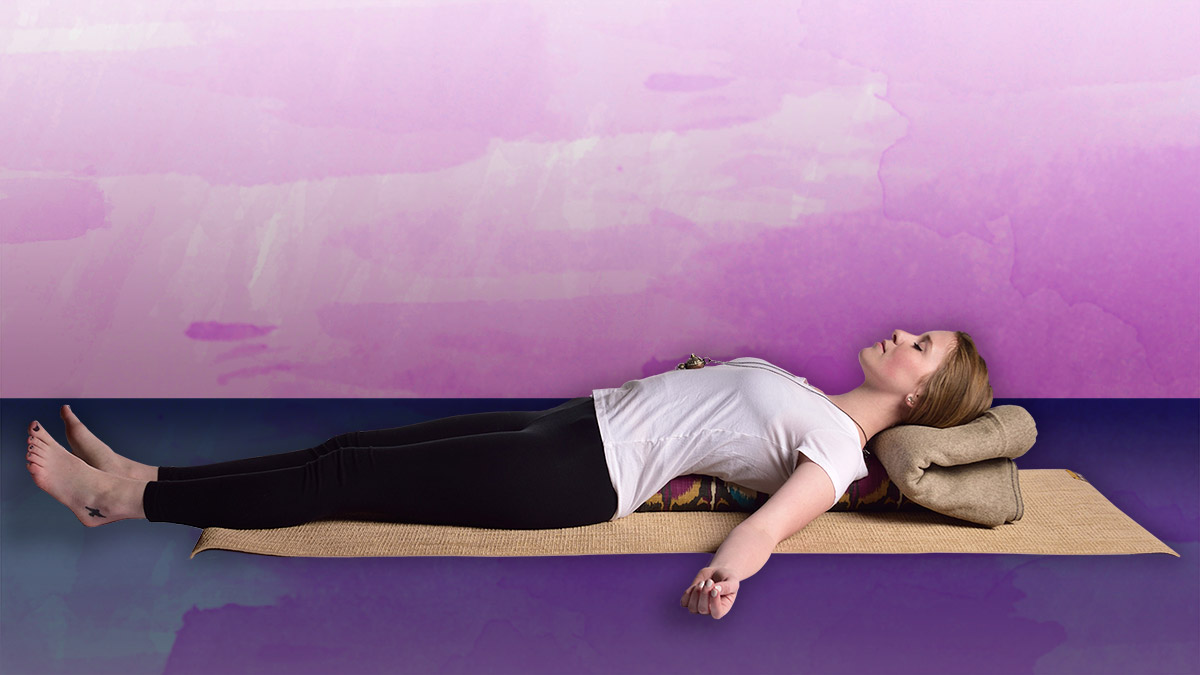When we think of pranayama (breathing practice), our minds often conjure up a vision of someone sitting in Padmasana (Lotus Pose) or Sukhasana (Cross-Legged Pose). While pranayama has traditionally been practiced in a seated position, BKS Iyengar, master of props and adaptations, determined that sitting was not the best position for everyone.
To accommodate these students, Iyengar came up with a way to allow practitioners to practice in a supine position. Placing a pranayama pillow under the spine from the lumbar to the head, and a blanket supporting the head and neck (see the above photo), any practitioner, no matter what their body type or physical condition, can enjoy an expanded chest and lengthened spine. The blanket supporting the head promotes a gentle form of jalandhara bandha (chin lock) to keep the prana from rushing up into the head and possibly causing a headache.
When I studied with the Iyengars in India in the 1980s, we practiced supine pranayama every afternoon. We also practiced seated pranayama, but probably 2/3 of our practice was spent lying down. Supine pranayama is appropriate for pretty much anyone, from beginners to experienced practitioners. It’s especially welcome to practice lying down when you come to practice in a state of fatigue. Not having to hold your body up allows you to concentrate solely on the breath.
While you can use folded blankets to support you in supine pranayama, variations in thickness and density make blankets unpredictable. Iyengar designed a bolster specifically sized for pranayama practice. Way back in the 1980s, Hugger Mugger began making pranayama yoga bolsters that fit Iyengar’s specifications. Pranayama yoga bolsters are, of course, designed for pranayama practice, but you can use them in other ways as well.
3 Ways to Use Pranayama Yoga Bolsters
- Pranayama: Place your pranayama lengthwise on the “head” end of your yoga mat. Place a folded blanket or small pillow at the head of your pranayama bolster. Sit in front of the pranayama yoga bolster so that your glutes are barely touching the end. Lie back onto the pranayama bolster and adjust the folded blanket so that it supports both your head and neck and tilts your head a bit forward. Place your arms between 45- and 90-degree angle next to your body and turn your palms up. Breathe!
- Savasana: Sometimes we need just a little bit of support under our knees for a comfortable Savasana. Pranayama yoga bolsters are much narrower than Standard, Round or Junior bolsters. While all three of these bolster types can be appropriate as Savasana props, pranayama bolsters, placed crosswise under the knees, are great for people who prefer just a little extra support.
- Passive back bending: Because of their narrow width and shorter height, pranayama yoga bolsters are comfortable for just about anyone in passive back bending. Sit on a yoga mat. Place the bolster crosswise somewhere a little above the center point of your mat. Lie back and adjust the bolster so that it is under your lumbar spine. Relax and enjoy.
Pranayama yoga bolsters are handmade here at Hugger Mugger’s Salt Lake City-based facility. They are filled with cotton batting and covered with sturdy upholstery-grade fabrics. The bolsters come in solid or printed designs.

